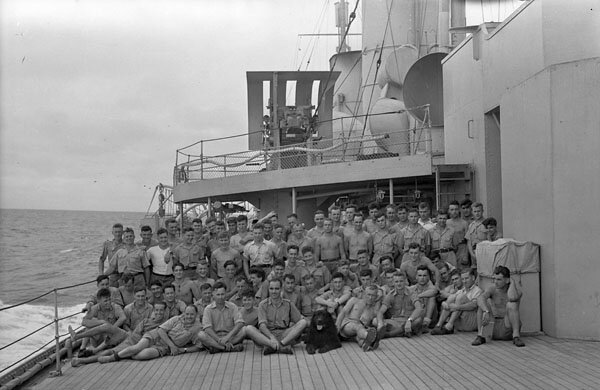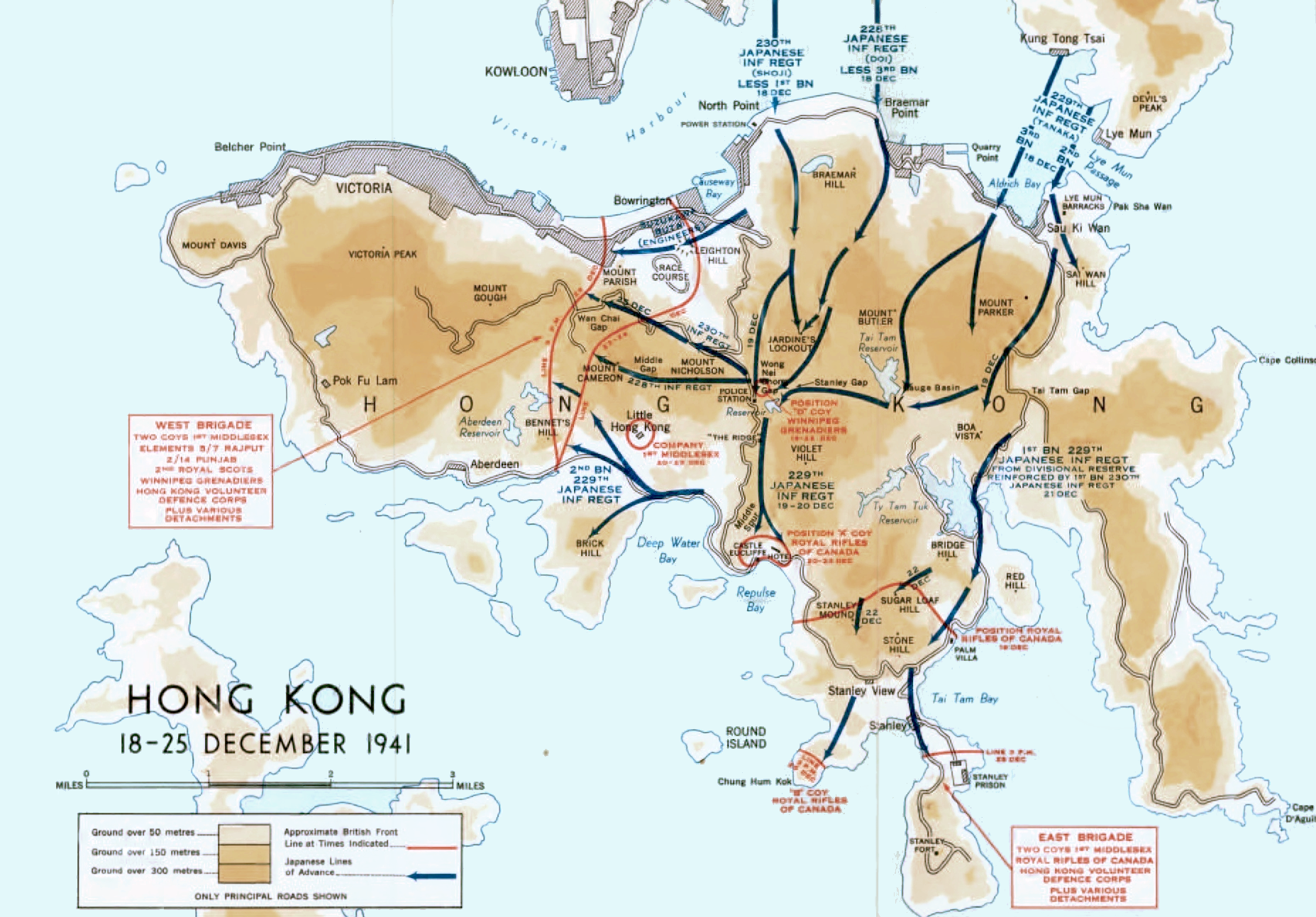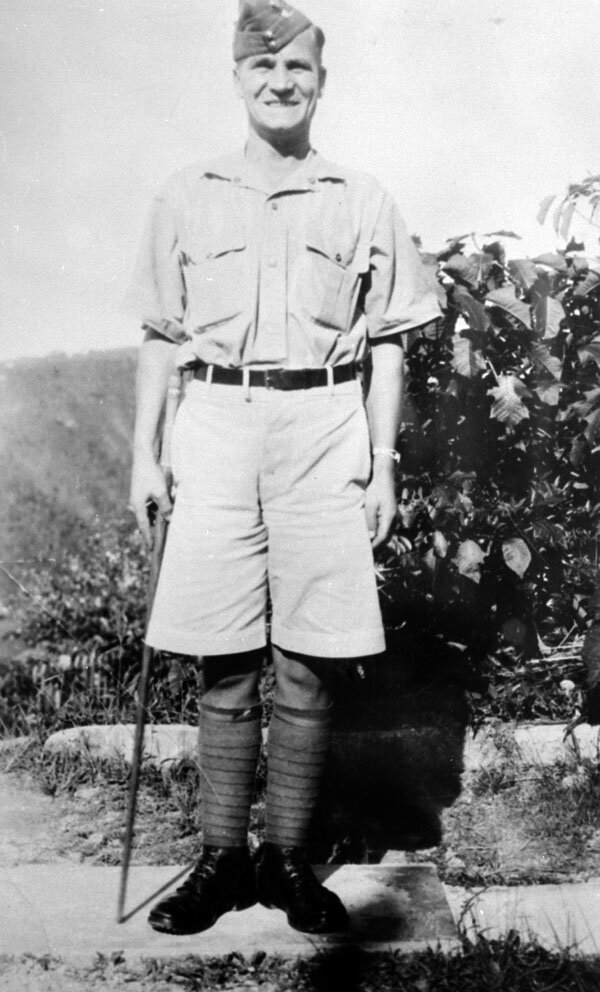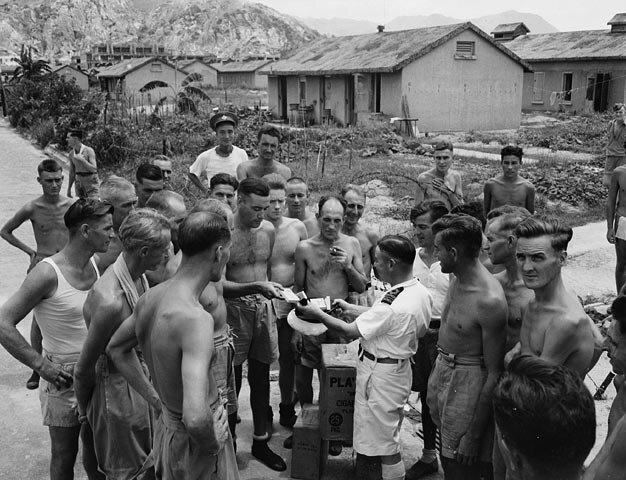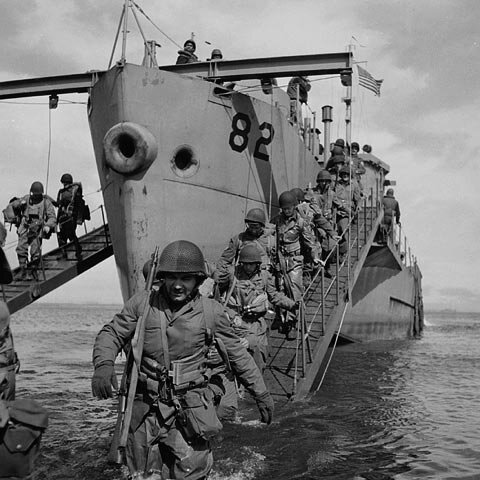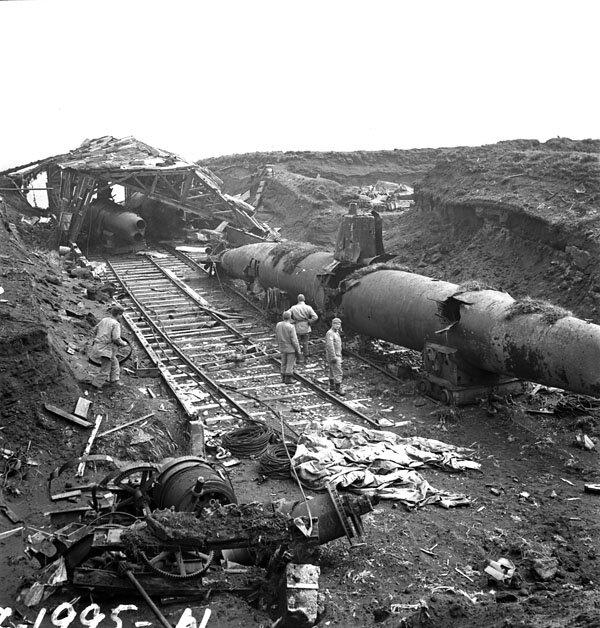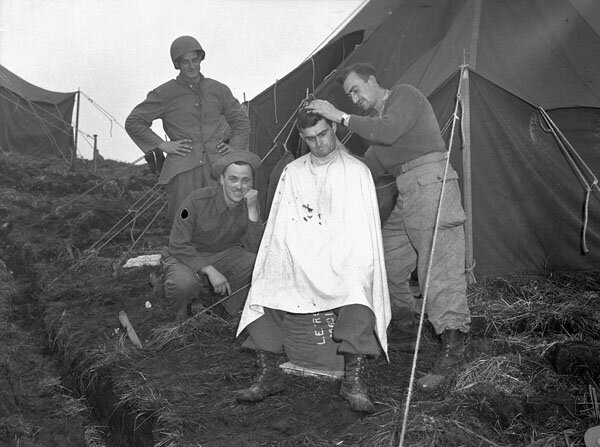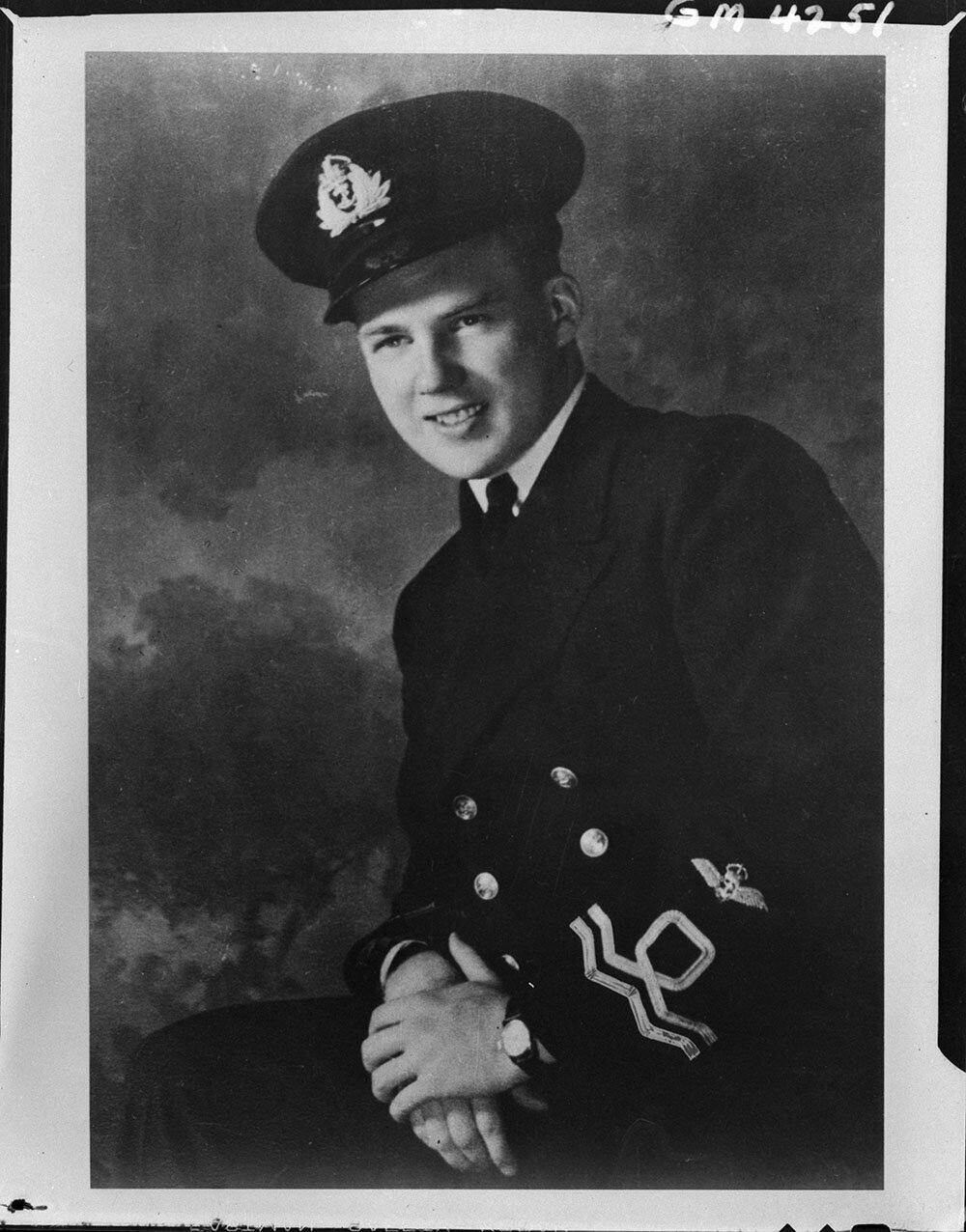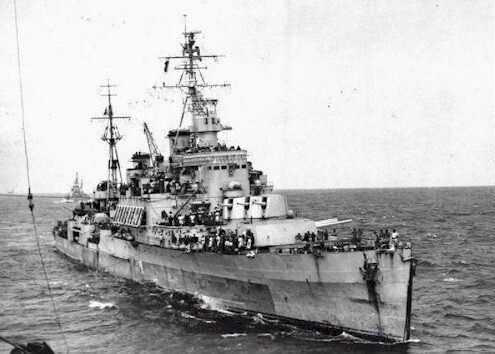Canadians in the Pacific Theatre of Operations
By Brad St. Croix
Canada’s Second World War in the Pacific Theatre began at Hong Kong on the 8th of December 1941 and continued until its dramatic and sudden conclusion in the summer of 1945. Canada’s involvement in the Pacific has been greatly overshadowed by the war in Europe. This situation does not mean that Canada made a minimal contribution to the fight against Japan.
Infantrymen of "C" Company, Royal Rifles of Canada, aboard H.M.C.S. PRINCE ROBERT en route to Hong Kong, 15 November 1941 Item ID number:3228792
Battle of Hong Kong
Canada’s first contribution to the Pacific Theatre came at the Battle of Hong Kong. 1,975 Canadian troops were sent to the British colony to bolster its garrison in hopes of deterring a Japanese attack. The Royal Rifles of Canada and the Winnipeg Grenadiers were selected as the core of “C” Force, the name given to the Canadian reinforcement of Hong Kong. Arriving in November 1941, the Canadians had little time before the Japanese attacked. They joined the 2nd Battalion the Royal Scots Regiment, 1st Battalion the Middlesex Regiment, 5th Battalion 7th Rajput Regiment, 2nd Battalion 14th Punjab Regiment, the Hong Kong Chinese Regiment, and the Hong Kong Volunteer Defence Corps in defending the colony. Various Royal Artillery units and a detachment of Royal Engineers completed the garrison order of battle.
The garrison’s troops faced the experienced Japanese 38th Division, comprised of the 228th Infantry Regiment, 229th Infantry Regiment, and 230th Infantry Regiment. They were supported by numerous artillery and mortar units, engineers, aircraft, and signallers.
The Battle of Hong Kong began on the 8th of December when Japanese forces attacked through the New Territories, the mainland portion of the colony, and bombed positions in Kowloon. The main defence line of the colony, the Gin Drinker’s Line, which was expected to stall the Japanese advance for at least several weeks, fell after only one day. This forced all garrison troops to retreat to Hong Kong Island. By the 11th, all garrison troops were on the island. They withstood the Japanese aerial and artillery bombardment for nearly seven days. The Japanese crossed the short Lye Mun Passage on the 18th of December and landed in the northeast corner of the island. ‘D’ Company of the Grenadiers’ stand against the Japanese at the Wong Nei Chong Gap is but one of the many examples of Canadian discipline under fire during the battle. Fighting continued until the garrison surrendered on Christmas Day 1941. 290 Canadians died in the battle. The entire Hong Kong garrison suffered 4,413 casualties, which includes 2,113 killed in action. The Japanese lost 675 killed and 2,079 wounded.
Many Canadians were awarded decorations for their actions at Hong Kong. Major Wells Bishop and Major Ernest Hodkinson were awarded the Distinguished Service Order. Sergeant Charles Clark, Corporal John Routledge, Sergeant Colin Standish, and Private Derek Rix were awarded the Distinguished Conduct Medal. Seven Canadian Officers were awarded the Military Cross, while thirteen Other Ranks were awarded the Military Medal.
Company Sergeant-Major J.R. Osborn of "A" Company, The Winnipeg Grenadiers, Jamaica, ca. 1940-1941. Killed in action at Hong Kong on 19 December 1941, CSM Osborn was posthumously awarded the Victoria Cross Item ID number:3225429
The only Victoria Cross awarded during the Battle of Hong Kong went to a Canadian. Company Sergeant Major John Osborn of the Winnipeg Grenadiers was awarded the highest honour for his actions on Mount Butler on the 19th of December. After leading the attack up the hill, Osborn helped to set up defence positions. Osborn single-handedly covered his company’s retreat to a new defensive position after a Japanese counterattack. When Japanese soldiers started lobbing grenades into the building in which they were sheltering, Osborn tossed them out one by one. A grenade landed where he could not throw out in time. Shouting a warning to his men, Osborn jumped on the grenade. He died instantly but saved many lives.
The survivors spent nearly four years as prisoners of war where they faced brutal conditions. They were subject to slave labour, starvation, beatings, and extremely unsanitary conditions. A further 264 Canadians died as prisoners of war. Many died from typhoid, cholera, and starvation-related illnesses. Some were beaten to death by Japanese guards and others were killed after an escape attempt. The prisoners of war were liberated in September 1945 after the Japanese surrender. Many Hong Kong veterans suffered from numerous ailments including alcoholism, psychological issues, and general poor health upon their return home and for years afterward.
Lieutenant-Commander Fred Day of H.M.C.S. PRINCE ROBERT meeting with liberated Canadian prisoners-of-war at Shamshuipo Camp, Kowloon, Hong Kong, September 1945 Item ID number:3617924
Aleutians Campaign
The Canadian Army’s second large contribution to the Pacific Theatre came during the Aleutians Campaign where several thousand Canadians participated in the American-led landing on Kiska in August 1943. American commanders deemed this action necessary as Japanese forces occupied Kiska, and Attu, in early June 1942, shortly after the Battle of Midway.
The Canadian contribution to the landings at Kiska included the 13th Brigade of the 6th Division. The infantry battalions were the Winnipeg Grenadiers, reconstituted after their destruction at Hong Kong, the Canadian Fusiliers, and the Rocky Mountain Rangers. A machinegun company from the Saint John Fusiliers was also attached to the brigade.
Canadian troops disembark in the Aleutian Islands Item ID number:3192166
The Canadian troops were placed under American command and Canadian units were reorganized along American lines. The three infantry battalions were turned into amphibious Battalion Landing Groups, which included small detachments of artillery, engineers, and other support sections. The 24th Field Regiment, Royal Canadian Artillery, along with the 24th Field Company, Royal Canadian Engineers, were attached to the force. Troops of the Le Regiment de Hull were to be used as beach combat teams to support the infantry battalions by unloading at the beaches and transferring vital supplies to the front. Le Regiment de Hull had many French Canadian conscripts among its ranks. In addition, the attack on Kiska was to be the first action of the First Special Service Force, a unit composed of American and Canadian soldiers. The combined American Canadian attack on Kiska included 34,426 soldiers, of which 5300 were Canadian.
Canadian and American soldiers examining abandoned Japanese submarines on Kiska, Aleutian Islands, 1 September 1943 Item ID number:3599747
The American commanders were unaware that the last Japanese troops left Kiska on the 29th of July 1943. The first landings were launched on the 15th of August 1943 followed by the landings of the 13th Brigade on Kiska on the 16th. They quickly discovered that the island had been evacuated. Despite the lack of Japanese soldiers, there still were Canadian casualties. Jittery soldiers expecting a bloody confrontation fired on their own patrols in the thick fog. Others were wounded and killed by enemy mines and booby-traps. The Canadians sustained eight casualties, four dead and four wounded. An officer of the Rocky Mountain Rangers was killed after he stepped on a mine. A private of the Winnipeg Grenadiers died instantly when he kicked a tripwire and detonated explosive charges. Le Regiment de Hull lost two men, both privates, due to the improper handling of Japanese ordnance.
The troops of the 13th Infantry Brigade remained on Kiska for more than three months. They lived in “winterized” tents, worked on road and pier construction, built and manned defences, and continued training. Fog, wind, and rain made the island an uncomfortable environment. Canadian troops were withdrawn to British Columbia beginning in November 1943 with the last shipload of Canadians leaving Kiska on the 12th of January 1944.
An unidentified infantryman of Le Régiment de Hull getting a haircut, Kiska, Aleutian Islands, August 1943 Item ID number:3230065
The Royal Canadian Air Force and Royal Canadian Navy made contributions to the Aleutians Campaign as well. In July 1942 part of No. 111 Squadron RCAF moved to Umnak, in the American controlled portion of the Aleutians. In September, it mounted its first operation against Kiska, from Adak Island. From March 1943, personnel of two RCAF fighter squadrons alternated operations against the Japanese on Attu and Kiska. The Royal Canadian Navy provided three-armed merchant cruisers and two corvettes. Like their Canadian Army compatriots, the sailors and aviators did not make any contact with the Japanese.
Canadian Pilots in the Pacific
Many personnel of the Royal Canadian Air Force and Royal Canadian Navy Volunteer Reserve served in other areas of the Pacific Theatre. They flew combat missions and transported supplies. On the 9th of August 1945, Lieutenant Robert Hampton Gray led a bombing mission against enemy shipping in Onagawa Wan, Japan. Despite damage to his plane, he sunk the Japanese escort vessel Amakusa. He crashed and did not survive. He was awarded the Victoria Cross posthumously for his actions. He is the last Canadian to be so awarded.
Lieutenant Robert Hampton Gray Item ID number:3205250
Royal Canadian Navy in the Pacific
The Royal Canadian Navy contributed HMCS Uganda to the Battle of Okinawa and the bombardment of Truk Island in spring 1945. The ships’ crew became infamous for their “munity” when the sailors voted against continued participation in the war against Japan. Conclusion
HMCS UGANDA Crown Colony Class Light Cruise
From 1941 to 1945, over 10,000 Canadians served in the Pacific Theatre. It was nearly much more as Canada was ready to send the 6th Canadian Division to the Pacific to fight in the invasion of Japan. The atomic bombing of Hiroshima and Nagasaki brought the war to an end before the 6th Division was sent to the Pacific.
Brad St Croix
Brad St.Croix is a PhD candidate in history at the University of Ottawa writing his thesis on the Battle of Hong Kong, and holds a BA and MA from the University of Western Ontario. Brad is a frequent presenter of Canadian Military History and has presented many conference papers on the subject. With a passion for history, Brad worked as a research assistant at the Canadian Research and Mapping Association.
Brad also runs the very popular On This Day in Military History twitter account: https://twitter.com/OnthisdayinC
Project ‘44: Forgotten Fronts
For the last three years, the Project ‘44 team has been mapping out Canada’s contribution in Europe. Starting with the famous DDay landings Project ‘44 mapped the entire Normandy campaign in 2019. In 2020 Project ‘44 mapped out the North West Europe Campaign covering the advance across France, through Belgium, the Liberation of the Netherlands and the crossing of the Rhine River into Germany. Most recently Project ‘44 has been mapping out the so-called “D-Day Dodgers” for its 2021 release of the Italian Campaign.
With the Italian Campaign set to launch in 2021, Project ‘44 has been developing its latest project to map out and explore Canada’s military history. We are proud to announce Project ‘44: Forgotten Fronts. This project will focus on Four Key Areas:
The Homefront
British Commonwealth Air Training Plan
The Battle of Hong Kong
The Aleutian Island Campaign
The project will create four new web maps for each of the key areas and provide key insights to help Canadians gain a better understanding of these underrepresented fronts. We will expand our approach to include new visualizations to explore data as interactive infographics. This information will provide Canadians with a deeper understanding of the effects of the Second World War at home.
We look forward to a successful launch of Project ‘44: Forgotten Fronts in 2022.

